MHSMD1SCH - Social Determinants of Health: A Marmot Review Analysis
VerifiedAdded on 2023/06/14
|8
|2236
|401
Essay
AI Summary
This essay provides a detailed analysis of the social determinants of health, focusing on the Marmot Review and its implications. It discusses how social and economic factors such as income, education, housing, and employment status influence health outcomes. The essay highlights the disparities in health among different social groups and the importance of addressing these inequalities through public health policies and interventions. It also examines strategies to reduce health inequalities, drawing from examples in the United Kingdom and emphasizing the role of nurses and community-based initiatives in promoting equitable access to healthcare services. The essay concludes by stressing the need for a comprehensive approach that considers the social well-being of individuals in the development of treatment plans and healthcare policies. Desklib offers a platform to explore similar solved assignments and resources for students.
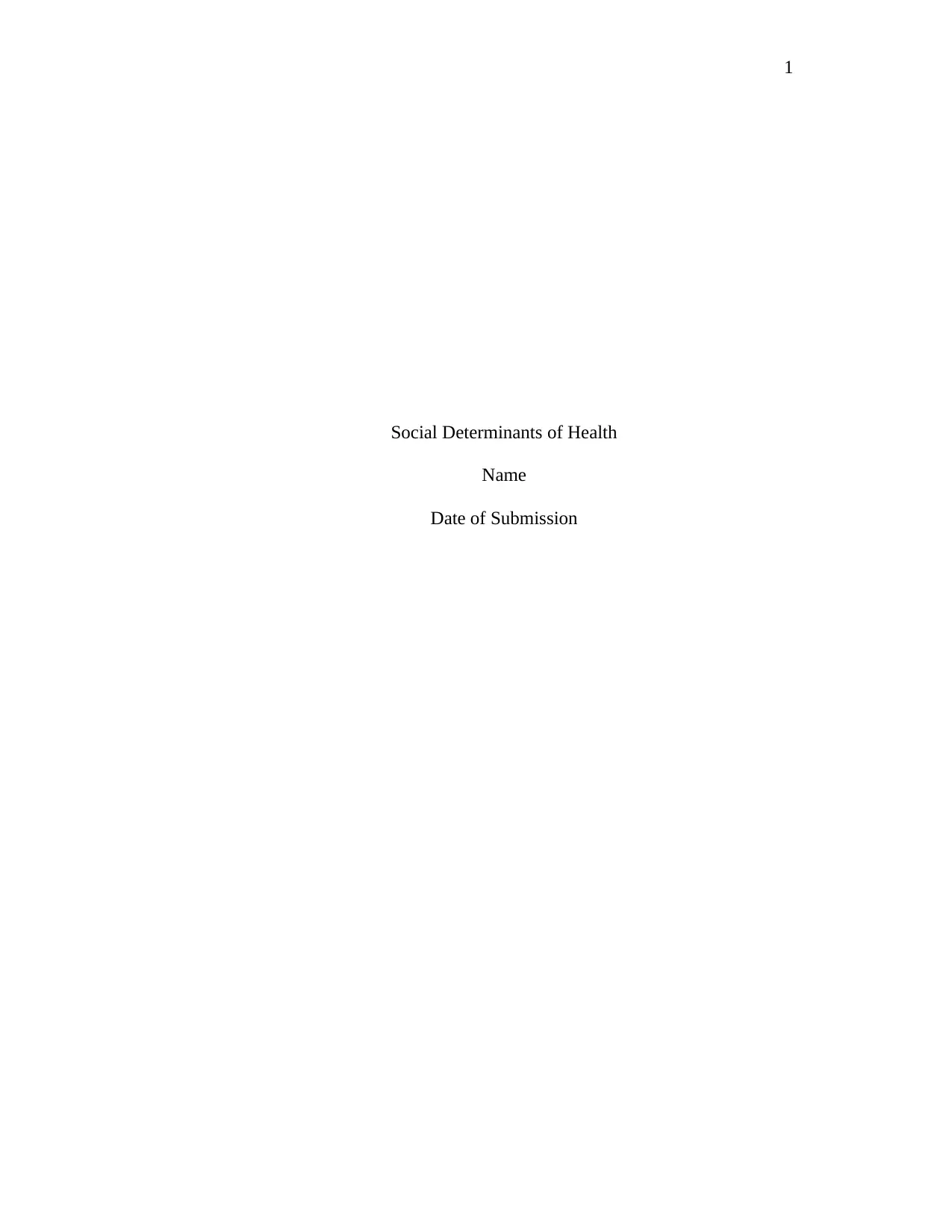
1
Social Determinants of Health
Name
Date of Submission
Social Determinants of Health
Name
Date of Submission
Secure Best Marks with AI Grader
Need help grading? Try our AI Grader for instant feedback on your assignments.
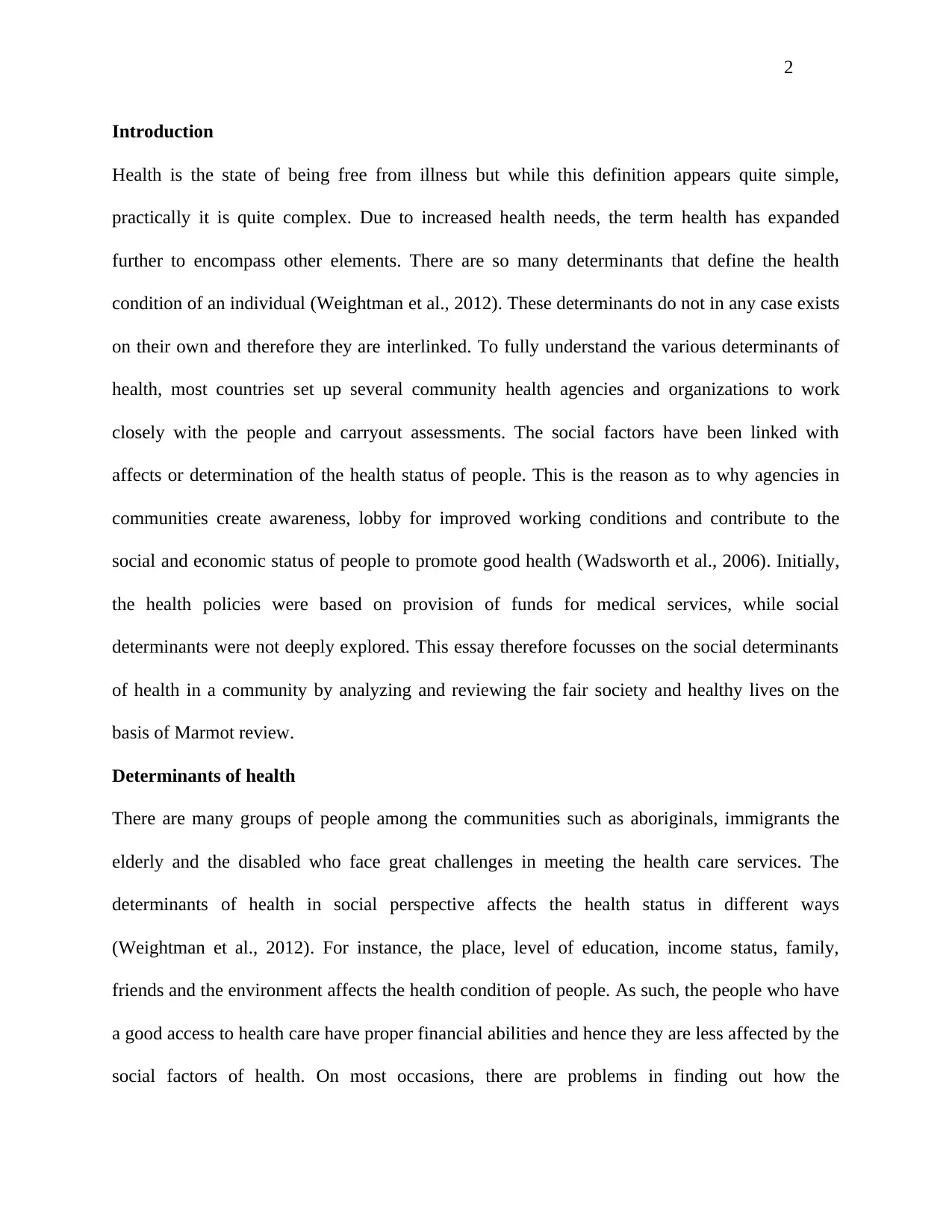
2
Introduction
Health is the state of being free from illness but while this definition appears quite simple,
practically it is quite complex. Due to increased health needs, the term health has expanded
further to encompass other elements. There are so many determinants that define the health
condition of an individual (Weightman et al., 2012). These determinants do not in any case exists
on their own and therefore they are interlinked. To fully understand the various determinants of
health, most countries set up several community health agencies and organizations to work
closely with the people and carryout assessments. The social factors have been linked with
affects or determination of the health status of people. This is the reason as to why agencies in
communities create awareness, lobby for improved working conditions and contribute to the
social and economic status of people to promote good health (Wadsworth et al., 2006). Initially,
the health policies were based on provision of funds for medical services, while social
determinants were not deeply explored. This essay therefore focusses on the social determinants
of health in a community by analyzing and reviewing the fair society and healthy lives on the
basis of Marmot review.
Determinants of health
There are many groups of people among the communities such as aboriginals, immigrants the
elderly and the disabled who face great challenges in meeting the health care services. The
determinants of health in social perspective affects the health status in different ways
(Weightman et al., 2012). For instance, the place, level of education, income status, family,
friends and the environment affects the health condition of people. As such, the people who have
a good access to health care have proper financial abilities and hence they are less affected by the
social factors of health. On most occasions, there are problems in finding out how the
Introduction
Health is the state of being free from illness but while this definition appears quite simple,
practically it is quite complex. Due to increased health needs, the term health has expanded
further to encompass other elements. There are so many determinants that define the health
condition of an individual (Weightman et al., 2012). These determinants do not in any case exists
on their own and therefore they are interlinked. To fully understand the various determinants of
health, most countries set up several community health agencies and organizations to work
closely with the people and carryout assessments. The social factors have been linked with
affects or determination of the health status of people. This is the reason as to why agencies in
communities create awareness, lobby for improved working conditions and contribute to the
social and economic status of people to promote good health (Wadsworth et al., 2006). Initially,
the health policies were based on provision of funds for medical services, while social
determinants were not deeply explored. This essay therefore focusses on the social determinants
of health in a community by analyzing and reviewing the fair society and healthy lives on the
basis of Marmot review.
Determinants of health
There are many groups of people among the communities such as aboriginals, immigrants the
elderly and the disabled who face great challenges in meeting the health care services. The
determinants of health in social perspective affects the health status in different ways
(Weightman et al., 2012). For instance, the place, level of education, income status, family,
friends and the environment affects the health condition of people. As such, the people who have
a good access to health care have proper financial abilities and hence they are less affected by the
social factors of health. On most occasions, there are problems in finding out how the
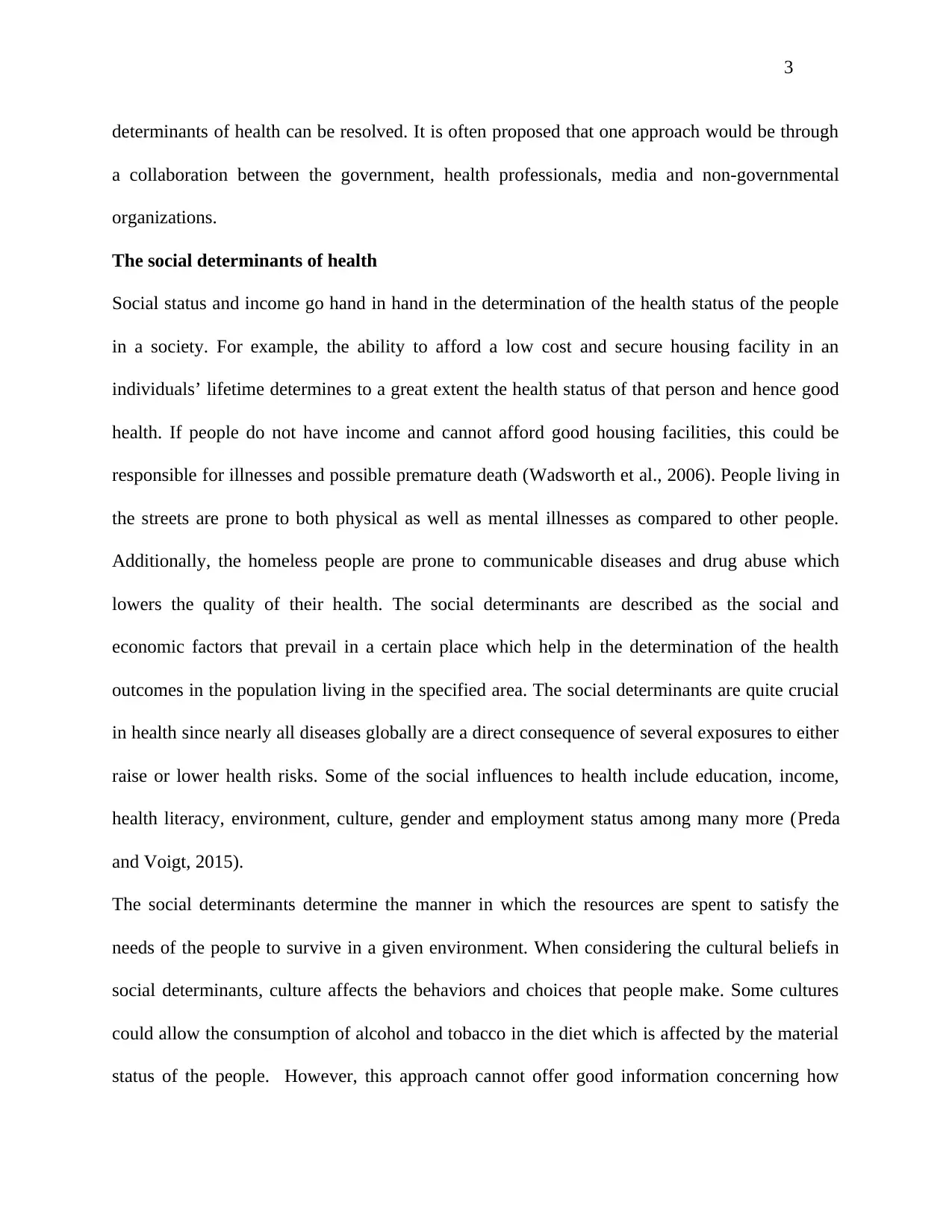
3
determinants of health can be resolved. It is often proposed that one approach would be through
a collaboration between the government, health professionals, media and non-governmental
organizations.
The social determinants of health
Social status and income go hand in hand in the determination of the health status of the people
in a society. For example, the ability to afford a low cost and secure housing facility in an
individuals’ lifetime determines to a great extent the health status of that person and hence good
health. If people do not have income and cannot afford good housing facilities, this could be
responsible for illnesses and possible premature death (Wadsworth et al., 2006). People living in
the streets are prone to both physical as well as mental illnesses as compared to other people.
Additionally, the homeless people are prone to communicable diseases and drug abuse which
lowers the quality of their health. The social determinants are described as the social and
economic factors that prevail in a certain place which help in the determination of the health
outcomes in the population living in the specified area. The social determinants are quite crucial
in health since nearly all diseases globally are a direct consequence of several exposures to either
raise or lower health risks. Some of the social influences to health include education, income,
health literacy, environment, culture, gender and employment status among many more (Preda
and Voigt, 2015).
The social determinants determine the manner in which the resources are spent to satisfy the
needs of the people to survive in a given environment. When considering the cultural beliefs in
social determinants, culture affects the behaviors and choices that people make. Some cultures
could allow the consumption of alcohol and tobacco in the diet which is affected by the material
status of the people. However, this approach cannot offer good information concerning how
determinants of health can be resolved. It is often proposed that one approach would be through
a collaboration between the government, health professionals, media and non-governmental
organizations.
The social determinants of health
Social status and income go hand in hand in the determination of the health status of the people
in a society. For example, the ability to afford a low cost and secure housing facility in an
individuals’ lifetime determines to a great extent the health status of that person and hence good
health. If people do not have income and cannot afford good housing facilities, this could be
responsible for illnesses and possible premature death (Wadsworth et al., 2006). People living in
the streets are prone to both physical as well as mental illnesses as compared to other people.
Additionally, the homeless people are prone to communicable diseases and drug abuse which
lowers the quality of their health. The social determinants are described as the social and
economic factors that prevail in a certain place which help in the determination of the health
outcomes in the population living in the specified area. The social determinants are quite crucial
in health since nearly all diseases globally are a direct consequence of several exposures to either
raise or lower health risks. Some of the social influences to health include education, income,
health literacy, environment, culture, gender and employment status among many more (Preda
and Voigt, 2015).
The social determinants determine the manner in which the resources are spent to satisfy the
needs of the people to survive in a given environment. When considering the cultural beliefs in
social determinants, culture affects the behaviors and choices that people make. Some cultures
could allow the consumption of alcohol and tobacco in the diet which is affected by the material
status of the people. However, this approach cannot offer good information concerning how
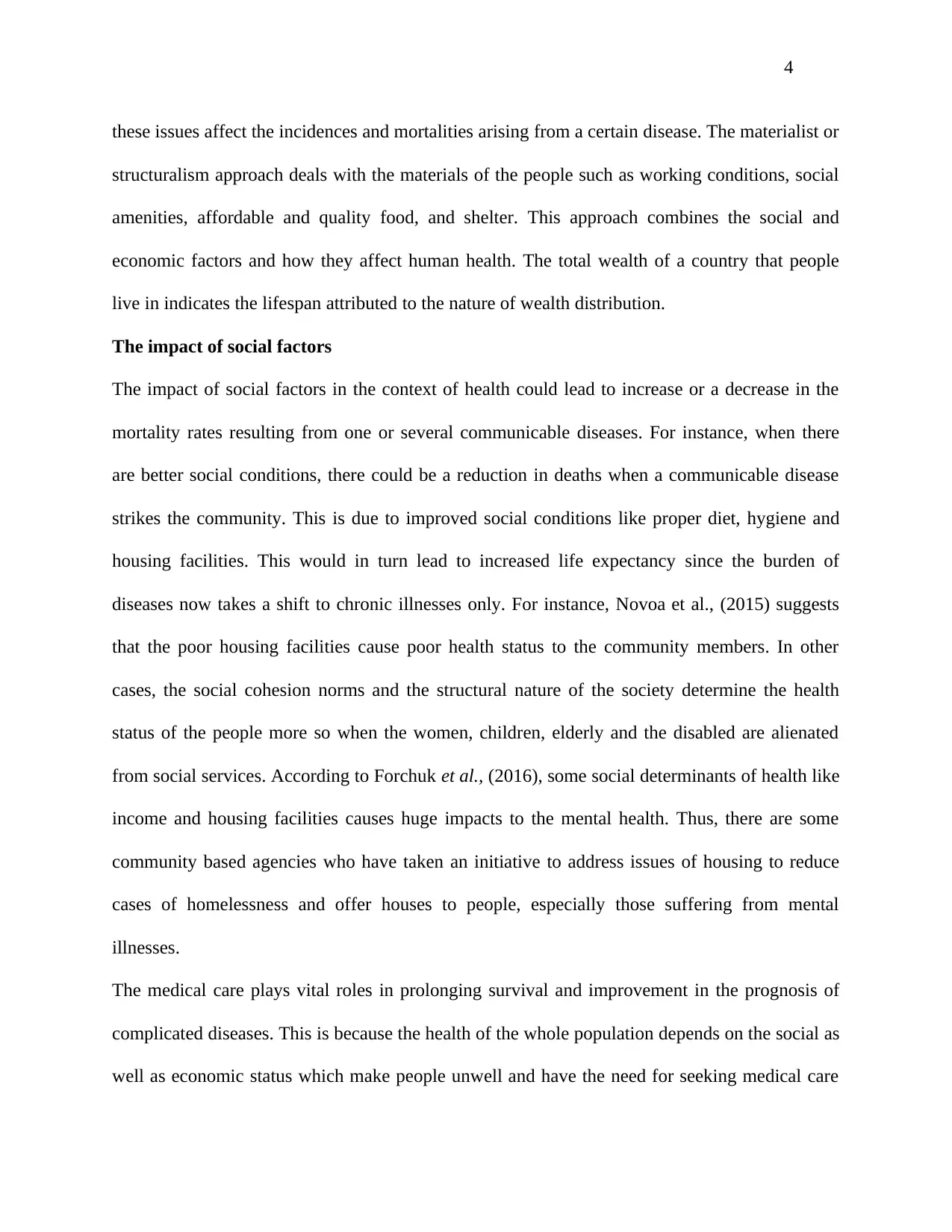
4
these issues affect the incidences and mortalities arising from a certain disease. The materialist or
structuralism approach deals with the materials of the people such as working conditions, social
amenities, affordable and quality food, and shelter. This approach combines the social and
economic factors and how they affect human health. The total wealth of a country that people
live in indicates the lifespan attributed to the nature of wealth distribution.
The impact of social factors
The impact of social factors in the context of health could lead to increase or a decrease in the
mortality rates resulting from one or several communicable diseases. For instance, when there
are better social conditions, there could be a reduction in deaths when a communicable disease
strikes the community. This is due to improved social conditions like proper diet, hygiene and
housing facilities. This would in turn lead to increased life expectancy since the burden of
diseases now takes a shift to chronic illnesses only. For instance, Novoa et al., (2015) suggests
that the poor housing facilities cause poor health status to the community members. In other
cases, the social cohesion norms and the structural nature of the society determine the health
status of the people more so when the women, children, elderly and the disabled are alienated
from social services. According to Forchuk et al., (2016), some social determinants of health like
income and housing facilities causes huge impacts to the mental health. Thus, there are some
community based agencies who have taken an initiative to address issues of housing to reduce
cases of homelessness and offer houses to people, especially those suffering from mental
illnesses.
The medical care plays vital roles in prolonging survival and improvement in the prognosis of
complicated diseases. This is because the health of the whole population depends on the social as
well as economic status which make people unwell and have the need for seeking medical care
these issues affect the incidences and mortalities arising from a certain disease. The materialist or
structuralism approach deals with the materials of the people such as working conditions, social
amenities, affordable and quality food, and shelter. This approach combines the social and
economic factors and how they affect human health. The total wealth of a country that people
live in indicates the lifespan attributed to the nature of wealth distribution.
The impact of social factors
The impact of social factors in the context of health could lead to increase or a decrease in the
mortality rates resulting from one or several communicable diseases. For instance, when there
are better social conditions, there could be a reduction in deaths when a communicable disease
strikes the community. This is due to improved social conditions like proper diet, hygiene and
housing facilities. This would in turn lead to increased life expectancy since the burden of
diseases now takes a shift to chronic illnesses only. For instance, Novoa et al., (2015) suggests
that the poor housing facilities cause poor health status to the community members. In other
cases, the social cohesion norms and the structural nature of the society determine the health
status of the people more so when the women, children, elderly and the disabled are alienated
from social services. According to Forchuk et al., (2016), some social determinants of health like
income and housing facilities causes huge impacts to the mental health. Thus, there are some
community based agencies who have taken an initiative to address issues of housing to reduce
cases of homelessness and offer houses to people, especially those suffering from mental
illnesses.
The medical care plays vital roles in prolonging survival and improvement in the prognosis of
complicated diseases. This is because the health of the whole population depends on the social as
well as economic status which make people unwell and have the need for seeking medical care
Secure Best Marks with AI Grader
Need help grading? Try our AI Grader for instant feedback on your assignments.
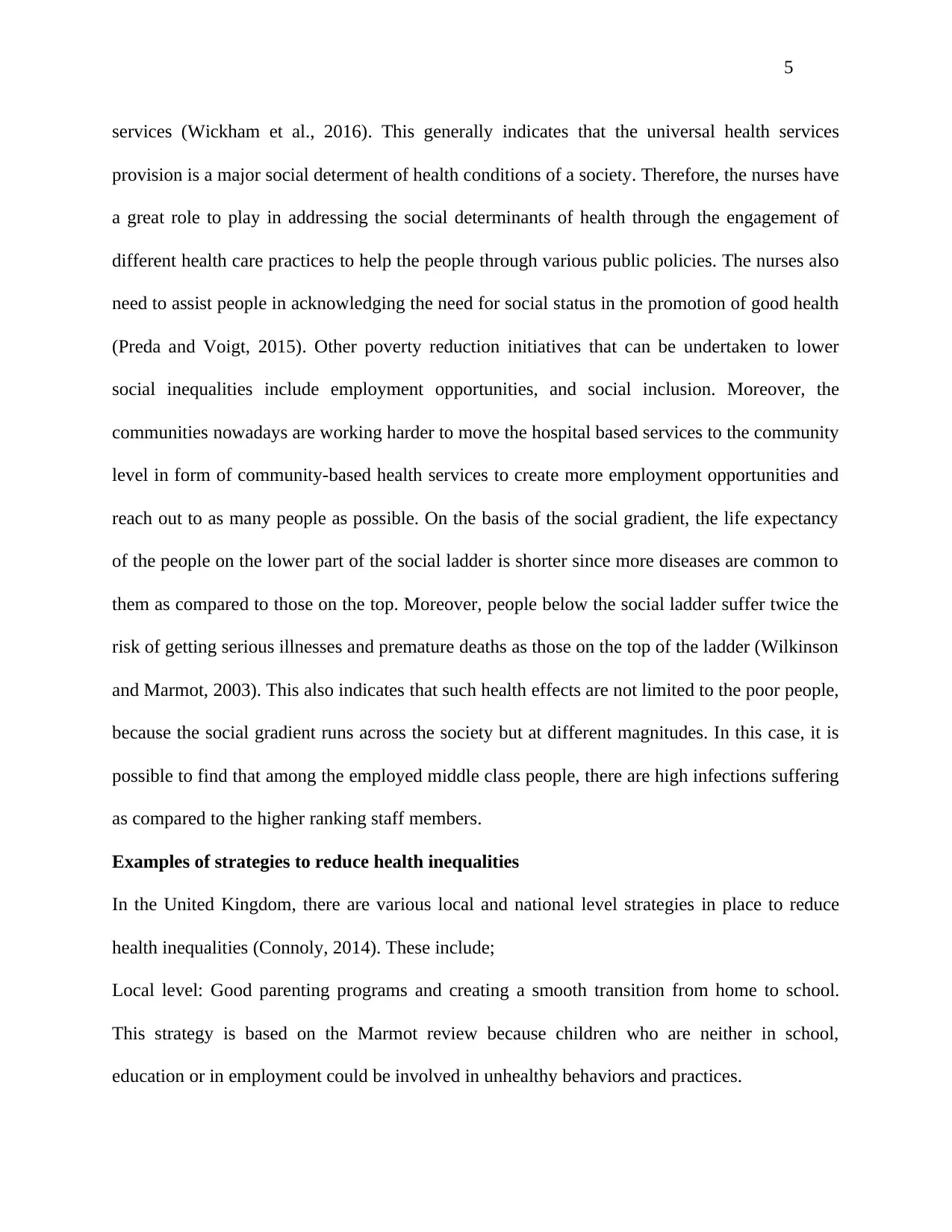
5
services (Wickham et al., 2016). This generally indicates that the universal health services
provision is a major social determent of health conditions of a society. Therefore, the nurses have
a great role to play in addressing the social determinants of health through the engagement of
different health care practices to help the people through various public policies. The nurses also
need to assist people in acknowledging the need for social status in the promotion of good health
(Preda and Voigt, 2015). Other poverty reduction initiatives that can be undertaken to lower
social inequalities include employment opportunities, and social inclusion. Moreover, the
communities nowadays are working harder to move the hospital based services to the community
level in form of community-based health services to create more employment opportunities and
reach out to as many people as possible. On the basis of the social gradient, the life expectancy
of the people on the lower part of the social ladder is shorter since more diseases are common to
them as compared to those on the top. Moreover, people below the social ladder suffer twice the
risk of getting serious illnesses and premature deaths as those on the top of the ladder (Wilkinson
and Marmot, 2003). This also indicates that such health effects are not limited to the poor people,
because the social gradient runs across the society but at different magnitudes. In this case, it is
possible to find that among the employed middle class people, there are high infections suffering
as compared to the higher ranking staff members.
Examples of strategies to reduce health inequalities
In the United Kingdom, there are various local and national level strategies in place to reduce
health inequalities (Connoly, 2014). These include;
Local level: Good parenting programs and creating a smooth transition from home to school.
This strategy is based on the Marmot review because children who are neither in school,
education or in employment could be involved in unhealthy behaviors and practices.
services (Wickham et al., 2016). This generally indicates that the universal health services
provision is a major social determent of health conditions of a society. Therefore, the nurses have
a great role to play in addressing the social determinants of health through the engagement of
different health care practices to help the people through various public policies. The nurses also
need to assist people in acknowledging the need for social status in the promotion of good health
(Preda and Voigt, 2015). Other poverty reduction initiatives that can be undertaken to lower
social inequalities include employment opportunities, and social inclusion. Moreover, the
communities nowadays are working harder to move the hospital based services to the community
level in form of community-based health services to create more employment opportunities and
reach out to as many people as possible. On the basis of the social gradient, the life expectancy
of the people on the lower part of the social ladder is shorter since more diseases are common to
them as compared to those on the top. Moreover, people below the social ladder suffer twice the
risk of getting serious illnesses and premature deaths as those on the top of the ladder (Wilkinson
and Marmot, 2003). This also indicates that such health effects are not limited to the poor people,
because the social gradient runs across the society but at different magnitudes. In this case, it is
possible to find that among the employed middle class people, there are high infections suffering
as compared to the higher ranking staff members.
Examples of strategies to reduce health inequalities
In the United Kingdom, there are various local and national level strategies in place to reduce
health inequalities (Connoly, 2014). These include;
Local level: Good parenting programs and creating a smooth transition from home to school.
This strategy is based on the Marmot review because children who are neither in school,
education or in employment could be involved in unhealthy behaviors and practices.
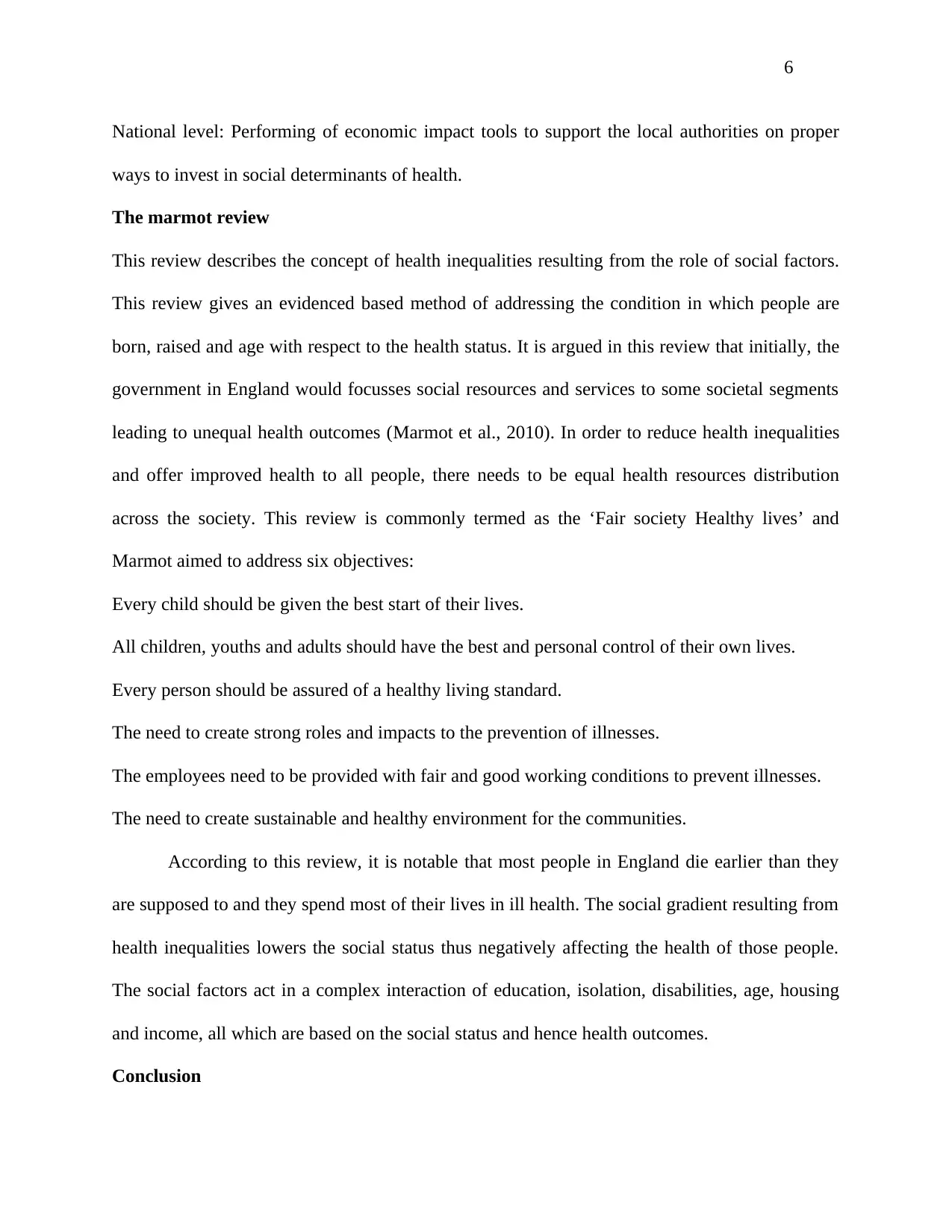
6
National level: Performing of economic impact tools to support the local authorities on proper
ways to invest in social determinants of health.
The marmot review
This review describes the concept of health inequalities resulting from the role of social factors.
This review gives an evidenced based method of addressing the condition in which people are
born, raised and age with respect to the health status. It is argued in this review that initially, the
government in England would focusses social resources and services to some societal segments
leading to unequal health outcomes (Marmot et al., 2010). In order to reduce health inequalities
and offer improved health to all people, there needs to be equal health resources distribution
across the society. This review is commonly termed as the ‘Fair society Healthy lives’ and
Marmot aimed to address six objectives:
Every child should be given the best start of their lives.
All children, youths and adults should have the best and personal control of their own lives.
Every person should be assured of a healthy living standard.
The need to create strong roles and impacts to the prevention of illnesses.
The employees need to be provided with fair and good working conditions to prevent illnesses.
The need to create sustainable and healthy environment for the communities.
According to this review, it is notable that most people in England die earlier than they
are supposed to and they spend most of their lives in ill health. The social gradient resulting from
health inequalities lowers the social status thus negatively affecting the health of those people.
The social factors act in a complex interaction of education, isolation, disabilities, age, housing
and income, all which are based on the social status and hence health outcomes.
Conclusion
National level: Performing of economic impact tools to support the local authorities on proper
ways to invest in social determinants of health.
The marmot review
This review describes the concept of health inequalities resulting from the role of social factors.
This review gives an evidenced based method of addressing the condition in which people are
born, raised and age with respect to the health status. It is argued in this review that initially, the
government in England would focusses social resources and services to some societal segments
leading to unequal health outcomes (Marmot et al., 2010). In order to reduce health inequalities
and offer improved health to all people, there needs to be equal health resources distribution
across the society. This review is commonly termed as the ‘Fair society Healthy lives’ and
Marmot aimed to address six objectives:
Every child should be given the best start of their lives.
All children, youths and adults should have the best and personal control of their own lives.
Every person should be assured of a healthy living standard.
The need to create strong roles and impacts to the prevention of illnesses.
The employees need to be provided with fair and good working conditions to prevent illnesses.
The need to create sustainable and healthy environment for the communities.
According to this review, it is notable that most people in England die earlier than they
are supposed to and they spend most of their lives in ill health. The social gradient resulting from
health inequalities lowers the social status thus negatively affecting the health of those people.
The social factors act in a complex interaction of education, isolation, disabilities, age, housing
and income, all which are based on the social status and hence health outcomes.
Conclusion
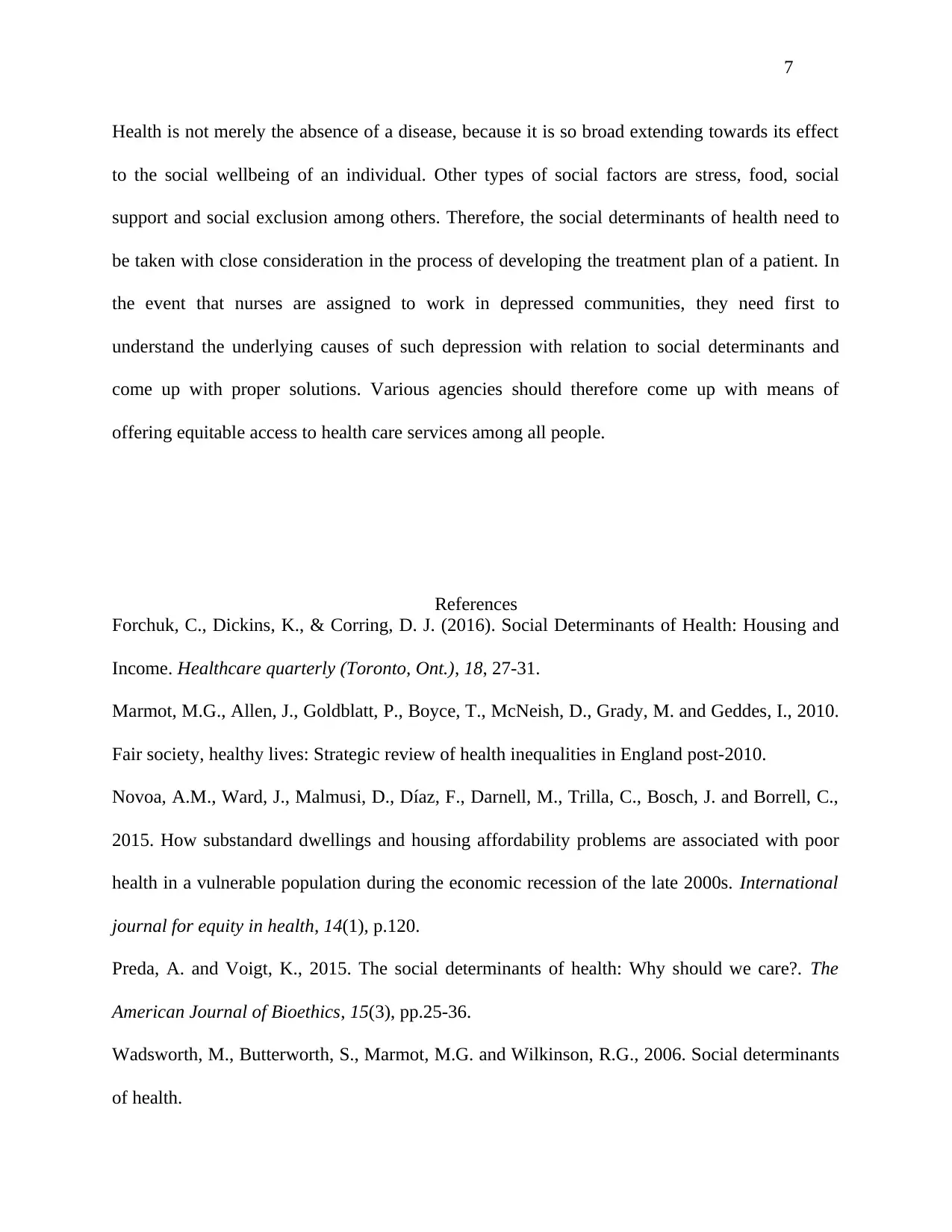
7
Health is not merely the absence of a disease, because it is so broad extending towards its effect
to the social wellbeing of an individual. Other types of social factors are stress, food, social
support and social exclusion among others. Therefore, the social determinants of health need to
be taken with close consideration in the process of developing the treatment plan of a patient. In
the event that nurses are assigned to work in depressed communities, they need first to
understand the underlying causes of such depression with relation to social determinants and
come up with proper solutions. Various agencies should therefore come up with means of
offering equitable access to health care services among all people.
References
Forchuk, C., Dickins, K., & Corring, D. J. (2016). Social Determinants of Health: Housing and
Income. Healthcare quarterly (Toronto, Ont.), 18, 27-31.
Marmot, M.G., Allen, J., Goldblatt, P., Boyce, T., McNeish, D., Grady, M. and Geddes, I., 2010.
Fair society, healthy lives: Strategic review of health inequalities in England post-2010.
Novoa, A.M., Ward, J., Malmusi, D., Díaz, F., Darnell, M., Trilla, C., Bosch, J. and Borrell, C.,
2015. How substandard dwellings and housing affordability problems are associated with poor
health in a vulnerable population during the economic recession of the late 2000s. International
journal for equity in health, 14(1), p.120.
Preda, A. and Voigt, K., 2015. The social determinants of health: Why should we care?. The
American Journal of Bioethics, 15(3), pp.25-36.
Wadsworth, M., Butterworth, S., Marmot, M.G. and Wilkinson, R.G., 2006. Social determinants
of health.
Health is not merely the absence of a disease, because it is so broad extending towards its effect
to the social wellbeing of an individual. Other types of social factors are stress, food, social
support and social exclusion among others. Therefore, the social determinants of health need to
be taken with close consideration in the process of developing the treatment plan of a patient. In
the event that nurses are assigned to work in depressed communities, they need first to
understand the underlying causes of such depression with relation to social determinants and
come up with proper solutions. Various agencies should therefore come up with means of
offering equitable access to health care services among all people.
References
Forchuk, C., Dickins, K., & Corring, D. J. (2016). Social Determinants of Health: Housing and
Income. Healthcare quarterly (Toronto, Ont.), 18, 27-31.
Marmot, M.G., Allen, J., Goldblatt, P., Boyce, T., McNeish, D., Grady, M. and Geddes, I., 2010.
Fair society, healthy lives: Strategic review of health inequalities in England post-2010.
Novoa, A.M., Ward, J., Malmusi, D., Díaz, F., Darnell, M., Trilla, C., Bosch, J. and Borrell, C.,
2015. How substandard dwellings and housing affordability problems are associated with poor
health in a vulnerable population during the economic recession of the late 2000s. International
journal for equity in health, 14(1), p.120.
Preda, A. and Voigt, K., 2015. The social determinants of health: Why should we care?. The
American Journal of Bioethics, 15(3), pp.25-36.
Wadsworth, M., Butterworth, S., Marmot, M.G. and Wilkinson, R.G., 2006. Social determinants
of health.
Paraphrase This Document
Need a fresh take? Get an instant paraphrase of this document with our AI Paraphraser
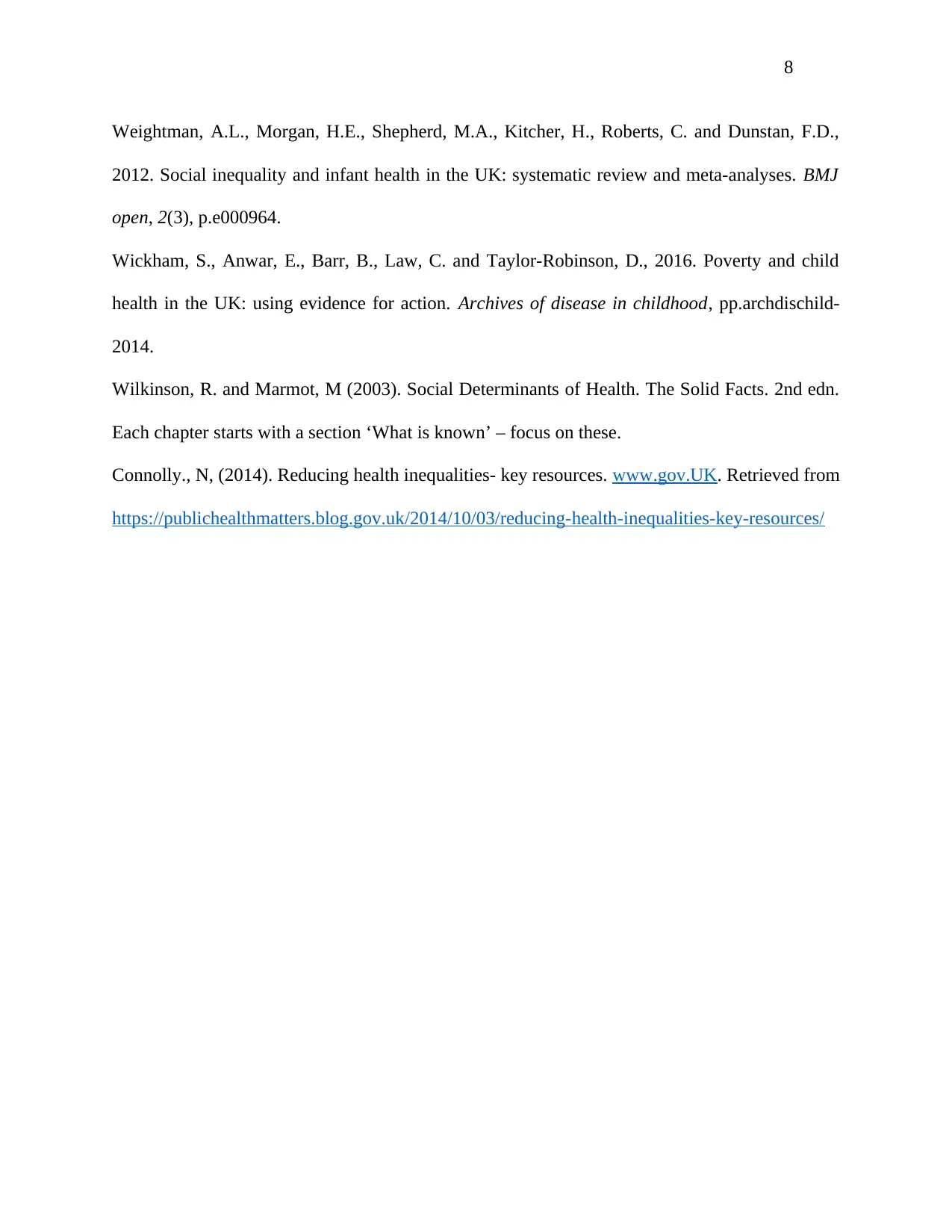
8
Weightman, A.L., Morgan, H.E., Shepherd, M.A., Kitcher, H., Roberts, C. and Dunstan, F.D.,
2012. Social inequality and infant health in the UK: systematic review and meta-analyses. BMJ
open, 2(3), p.e000964.
Wickham, S., Anwar, E., Barr, B., Law, C. and Taylor-Robinson, D., 2016. Poverty and child
health in the UK: using evidence for action. Archives of disease in childhood, pp.archdischild-
2014.
Wilkinson, R. and Marmot, M (2003). Social Determinants of Health. The Solid Facts. 2nd edn.
Each chapter starts with a section ‘What is known’ – focus on these.
Connolly., N, (2014). Reducing health inequalities- key resources. www.gov.UK. Retrieved from
https://publichealthmatters.blog.gov.uk/2014/10/03/reducing-health-inequalities-key-resources/
Weightman, A.L., Morgan, H.E., Shepherd, M.A., Kitcher, H., Roberts, C. and Dunstan, F.D.,
2012. Social inequality and infant health in the UK: systematic review and meta-analyses. BMJ
open, 2(3), p.e000964.
Wickham, S., Anwar, E., Barr, B., Law, C. and Taylor-Robinson, D., 2016. Poverty and child
health in the UK: using evidence for action. Archives of disease in childhood, pp.archdischild-
2014.
Wilkinson, R. and Marmot, M (2003). Social Determinants of Health. The Solid Facts. 2nd edn.
Each chapter starts with a section ‘What is known’ – focus on these.
Connolly., N, (2014). Reducing health inequalities- key resources. www.gov.UK. Retrieved from
https://publichealthmatters.blog.gov.uk/2014/10/03/reducing-health-inequalities-key-resources/
1 out of 8
Related Documents
Your All-in-One AI-Powered Toolkit for Academic Success.
+13062052269
info@desklib.com
Available 24*7 on WhatsApp / Email
![[object Object]](/_next/static/media/star-bottom.7253800d.svg)
Unlock your academic potential
© 2024 | Zucol Services PVT LTD | All rights reserved.




